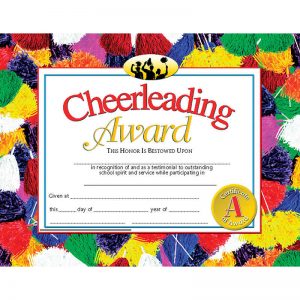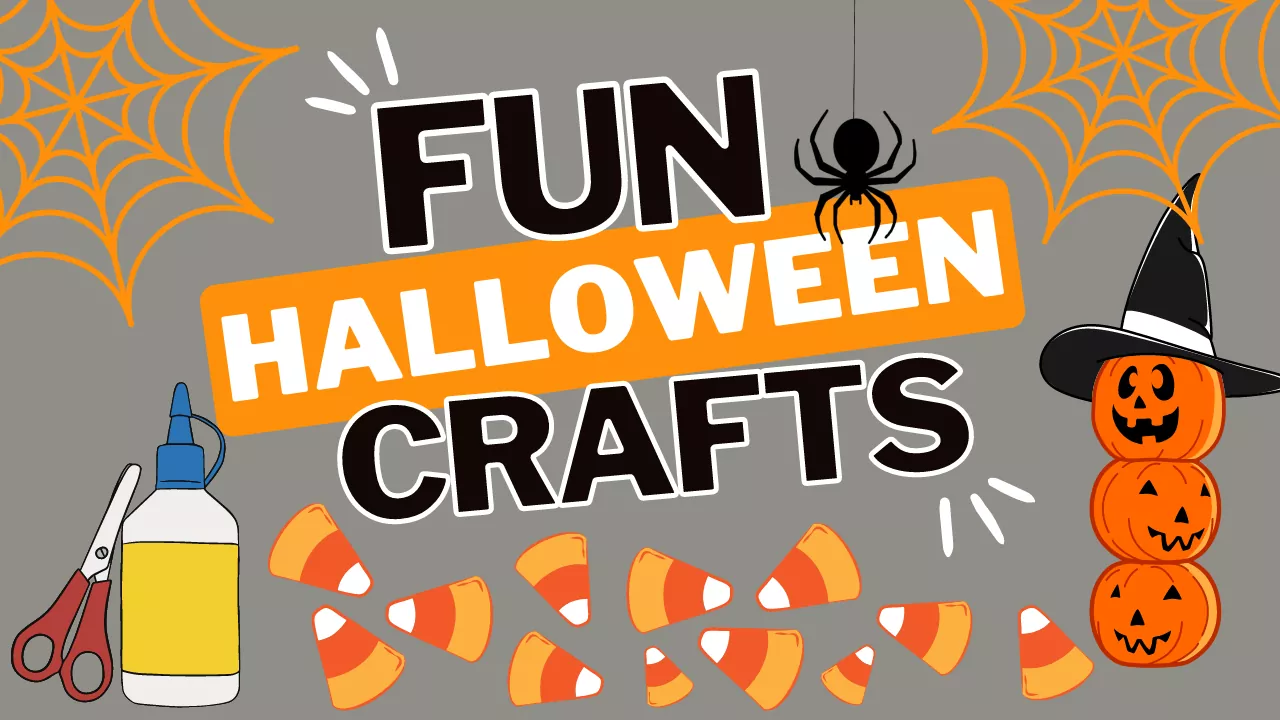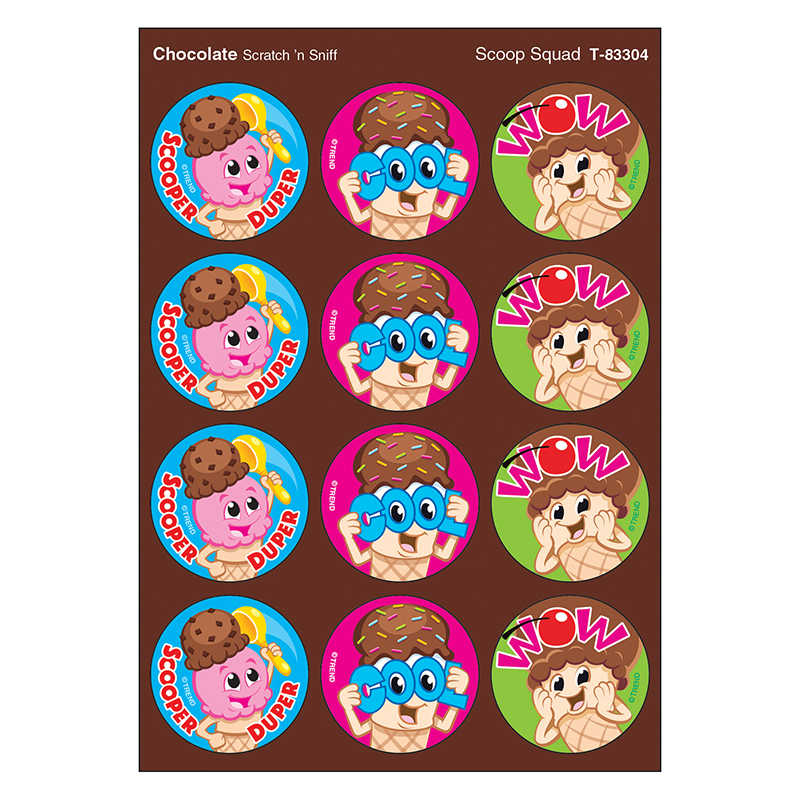Grade 5 Reading Comprehension Activities
A SHORT HISTORY OF THE MOVIES
Motion pictures, or “movies,” are less than 100 years old. In 1893 Thomas Edison invented a way to make pictures move. His moving pictures were shown in a little box and were nicknamed “peep shows.”
Edison’s first movies had no sound or color, and told no story. For example, The Strong Man was only a few minutes long and showed a famous strong man lifting a weight.
In 1903 Edwin Porter made one of the first films to tell a story. It was a western called The Great Train Robbery. The first westerns were made in New Jersey.
In 1915 D. W. Griffith made Birth of a Nation. It changed the way movies were made. It was technically better with many new camera tricks. It was also much more elaborate and very realistic.
WORKSHEET & Sample PDF Activity
[adinserter block=”2″]
Sample PDF Activity
[adinserter block=”3″]
By 1925 movies became very fancy with casts of thousands. For example, The Ten Commandments, made in 1925, used 4000 costumes, 50 elephants, and 5 tons of scenery. Movies had become big business, and the center of the business was a place called Hollywood!
In 1927 Hollywood produced the first “talking picture.” It was The Jazz Singer, a movie with sound. The Jazz Singer ended the days of the silent film and pointed towards the movies you see today.
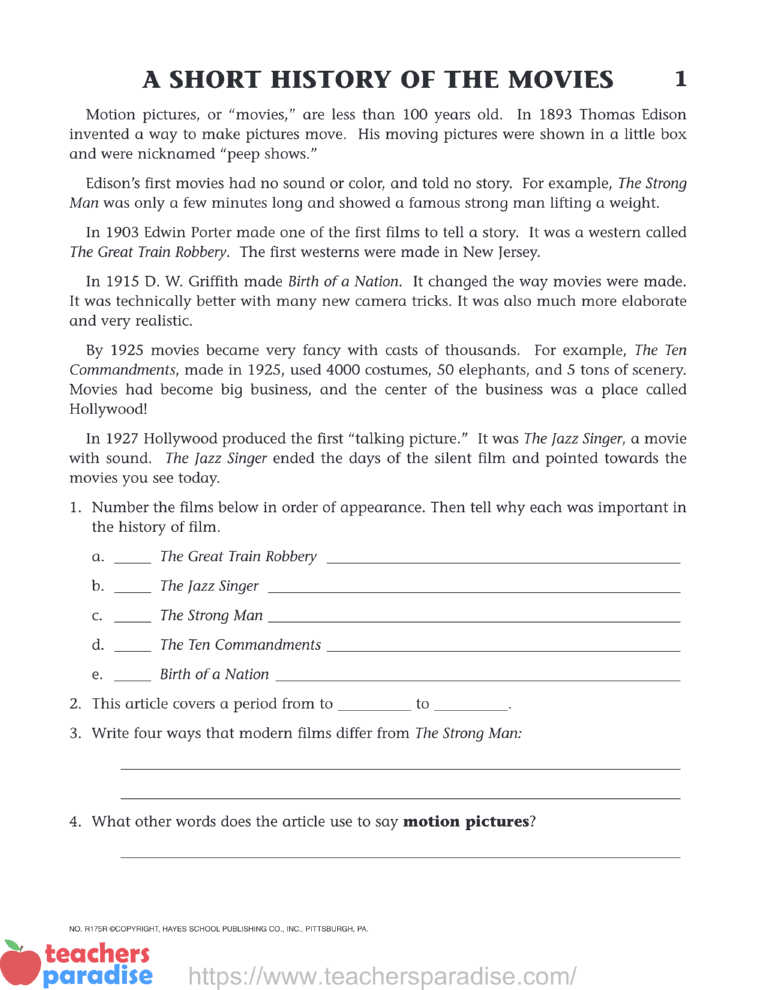
- Number the films below in order of appearance. Then tell why each was important in the history of film.
a. The Great Train Robbery –
b. The Jazz Singer –
c. The Strong Man –
d. The Ten Commandments –
e. Birth of a Nation – - This article covers a period from to _ to _.
- Write four ways that modern films differ from The Strong Man:
- What other words does the article use to say motion pictures?
THE MANY DEATHS OF MICHAEL MORIARTY
Michael Moriarty died today. In fact, he died several times. Mike is an actor. He is making a movie about spies in World War II. In the movie the spies kill Michael.
The spies hit Michael over the head with a chair. Mike collapses on the floor. Blood dribbles down his forehead. Suddenly Mike sits up and asks, “Was that okay?”
“No,” answers the director, “the chair fell apart too soon.”
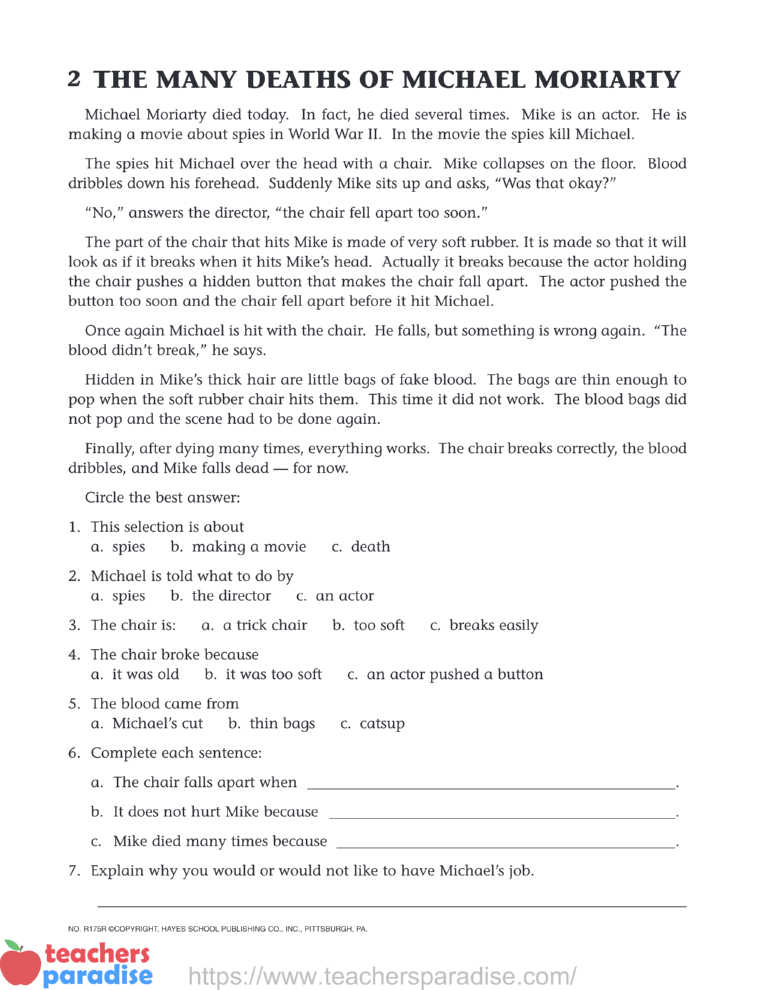
The part of the chair that hits Mike is made of very soft rubber. It is made so that it will look as if it breaks when it hits Mike’s head. Actually it breaks because the actor holding the chair pushes a hidden button that makes the chair fall apart. The actor pushed the button too soon and the chair fell apart before it hit Michael.
Once again Michael is hit with the chair. He falls, but something is wrong again. “The blood didn’t break,” he says.
Hidden in Mike’s thick hair are little bags of fake blood. The bags are thin enough to pop when the soft rubber chair hits them. This time it did not work. The blood bags did not pop and the scene had to be done again.
Finally, after dying many times, everything works. The chair breaks correctly, the blood dribbles, and Mike falls dead — for now.
Circle the best answer:
- This selection is about
a. spies
b. making a movie
c. death - Michael is told what to do by
a. spies
b. the director
c. an actor - The chair is:
a. a trick chair
b. too soft
c. breaks easily - The chair broke because
a. it was old
b. it was too soft
c. an actor pushed a button - The blood came from
a. Michael’s cut
b. thin bags
c. catsup - Complete each sentence:
a. The chair falls apart when ______________________________________.
b. It does not hurt Mike because ___________________________________.
c. Mike died many times because __________________________________. - Explain why you would or would not like to have Michael’s job.
Table of Contents
A Short History of the Movies (Sequence/Time Span/Main Idea) – 1
The Many Deaths of Michael Moriarty (Details/CauseEffect/Main Idea) – 2
The Big Dipper and Bugs Bunny (Word Meaning/Context Clues/Vocabulary Development) – 3
How to Get Information Quickly (Main Idea/Skimming) – 4
Overheard in Philadelphia (Main Idea/Inference) – 5
Sign Here, Mr Hancock (Classification/Details) – 6
Mrs Adams’s Pin (Form Class/Sentence Meaning/Context) – 7
What Would You Do? (Characterization/Empathy/Main Idea) – 8, 9
A Puzzle Fit for a King or Queen (Vocabulary/Context Clues) – 10
Words That Describe (Descriptive Words/Classifying) – 11
The Whistler (Introduction to Library/Main Idea/Inference) – 12, 13
Using the Card Catalog (Card Catalog/Classifying) – 14
The Teeth of a Lion and Other Word Histories (Etymology/Dictionary) – 15
Sorry, Wrong Number! (Dialogue/Main Idea/Inference/Forecasting) – 16
All Thumbs (Idioms/Word Meaning/Phrase Meaning) – 17
Some Notes About Julia Ward Howe (Note Taking/Main Idea/Supporting Details) – 18, 19
Similes and Metaphors – 20
Noisy Words (Onomatopoetic or “Sound” Words) – 21
All About Bugs (Main Idea/Details/Outline Form) – 22, 23
Science Words (Alphabetical Order/Glossary) – 24
A Letter to Henry (Forecasting/Empathy/Main Idea) – 25
Take a Look at Your Ear (Picture Interpretation/Reading Diagrams/Details) – 26
The Author Is Up to What? (Author’s Purpose) – 27
Is That a Fact? – 28
Try and Try Again (Drawing Conclusions/Characterization) – 29
Meet Rube Goldberg (Cause-Effect/Sequence/Biography) – 30, 31
The Cat Show (Author’s Attitude/Inferences) – 32
Sobs, Sighs, and Snickers (Synonyms/Sentence Meaning/Context) – 33
Washington, D C , and How It Grew (Unstated Main Idea/Sequence/Detail) – 34, 35
Working With Prefixes (Prefix/Sentence Meaning/Antonyms) – 36
Make a Noun (Suffix/Noun Forming/Sentence Meaning/Vocabulary) – 37
Sending Messages (Main Idea/Details) – 38, 39
Ball-Point Pens (Main Idea/Cause-Effect/Reading Diagram) – 40
Lilly’s Lemonade Co , Inc (Abbreviations/Meaning) – 41
Words With More Than One Meaning (Context/Sentence Meaning) – 42
Ice, Water, and Steam (Classifying/Cause-Effect) – 43
Atoms and Molecules (Main Idea/Details/Reading for Specific Information) – 44, 45
Talking About the Weather (Drawing Conclusions/Summarizing/Inference) – 46
Weather Words (Vocabulary/Descriptive Words/Synonyms/Classifying) – 47
Child Laborers (Main Idea/Unstated Main Idea/Conclusions) – 48, 49
Why Do You Scratch When You Itch? (Main Idea/Cause-Effect/Conclusions) – 50
Using Your Brain (Details/Reading a Diagram) – 51
Brain Twisters (Homonyms/Context/Following Directions) 52
Word Histories (Word Histories/Main Idea/Classifying) – 53
Close-Call Charlie (Main Idea/Empathy/Details/Descriptive Words) – 54, 55
Two-Mouth and the Kid (Main Idea/ Details/Summary/Characterization) – 56, 57
Big Words Don’t Mean a Thing (Prefix/Root Word/Suffix/Vocabulary) – 58
Hidden Meanings (Context Clues/Vocabulary) – 59
Bicycle Safety Week (Main Idea/Summarizing) – 60
My, How You’ve Grown! (Inference/Reading Chart) – 61
Brain Ticklers (Analogies/Inference) – 62
A Mixed-Up Paragraph This Is! (Sequence/Details) – 63
Buried Treasure (Review/Following Directions) – 64


